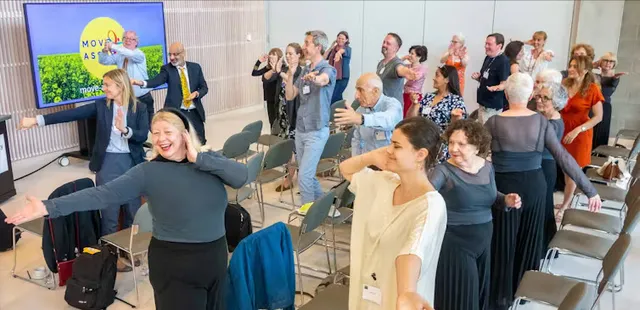
Breakdancing in the break room might not seem like the best way to get ahead at work, but research shows recreational dance can actually improve productivity performance in the workplace.
在休息室跳霹雳舞似乎不是在工作中出人头地的最佳方式,但研究表明,娱乐性舞蹈实际上可以提高工作效率。
It is well known that engaging in physical activity has many health benefits – from reducing the risk of diabetes, to lowering the risk of developing coronary heart diseases and dementia. The World Health Organization (WHO) has even linked the increasing incidence of noncommunicable diseases (those characterised by slow progression and long duration) to unhealthy life styles.
众所周知,参加体育锻炼对健康有很多益处--从降低患糖尿病的风险,到降低患冠心病和痴呆症的风险。世界卫生组织(WHO)甚至将非传染性疾病(进展缓慢、持续时间长的疾病)发病率的上升与不健康的生活方式联系起来。
If you still need motivation to move, there is evidence that a lack of physical exercise can result in lower earnings, and lower probability of finding employment or even being invited to interview.
如果您还需要运动的动力,那么有证据表明,缺乏体育锻炼会导致收入降低,找到工作或甚至被邀请参加面试的概率也会降低。
So, moving is good for you. But when it comes to work, our research shows that dance, in particular, could help you – and your company – get ahead.
因此,运动对你有好处。但在工作中,我们的研究表明,舞蹈尤其可以帮助你和你的公司取得成功。
Let’s dance
让我们跳舞吧
Dance is special. Neuroscience and psychology researchers have not only recognised the positive health effects of dance but have also discovered that dancing has additional benefits compared to other forms of physical exercise. Cognitive psychologist – and dancer – Peter Lovatt explains that dance is a cognitive activity that engages the brain through learning dance routines, processing music and thinking about rhythm and coordination.
舞蹈很特别。神经科学和心理学研究人员不仅认识到舞蹈对健康的积极影响,还发现与其他形式的体育锻炼相比,舞蹈具有更多的益处。认知心理学家兼舞蹈家彼得-洛瓦特解释说,舞蹈是一种认知活动,它通过学习舞蹈动作、处理音乐以及思考节奏和协调性来调动大脑。
Several studies have focused on the benefits of dancing for the ageing brain and its effectiveness in improving quality of life among those affected by degenerative conditions such as Parkinson's disease. And while there have been no specific studies on the economics of dance, research tends to relate cognitive skills to higher wages and productivity.
有几项研究重点关注了舞蹈对大脑老化的益处,以及舞蹈在改善帕金森病等退化性疾病患者生活质量方面的有效性。虽然还没有关于舞蹈经济学的具体研究,但研究倾向于将认知技能与更高的薪水与生产力联系起来。
And so, because it improves cognitive abilities, we believe dance can also improve productivity in the workplace.
因此,由于舞蹈能提高认知能力,我们相信舞蹈也能提高工作场所的生产力。

The workplace benefits of dance
舞蹈的职场益处
To show this, we used a survey-based approach to collect data from a sample of dancers located in Italy, the UK and Brazil. We also collected data from a control group from the same three countries – these participants actively exercise but do not dance.
为了证明这一点,我们采用了一种基于调查的方法,从意大利、英国和巴西的舞者样本中收集数据。我们还从这三个国家的对照组中收集了数据--这些参与者积极锻炼但不跳舞。
To measure performance in the workplace, we used a selection of questions on absenteeism (not turning up to work) and presenteeism (not working as hard as usual when at work).
为了衡量工作场所的表现,我们选取了一些关于旷工(不上班)和缺勤(上班时没有像平时一样努力工作)的问题。
We picked five questions from the WHO's Health and Work Performance questionnaire to measure presenteeism: how often respondents have not worked when they were supposed to, how often they have not worked carefully, how often their work has been of poor quality, how often they have not been concentrating while working, and how they self-rate their job performance.
我们从世界卫生组织的 "健康与工作表现 "问卷中选取了五个问题来衡量旷工现象:受访者在应该工作的时间没有工作的频率、没有认真工作的频率、工作质量不高的频率、工作时注意力不集中的频率以及对工作表现的自我评价。
To evaluate absenteeism, we used respondents' reports about how many times they had missed a whole day of work (or part of a day) for health reasons and for non-health related reasons over the week prior to the survey.
为了评估缺勤情况,我们使用了受访者的报告,即在调查前一周内,他们因健康原因和非健康原因缺勤一整天(或一天中的部分时间)的次数。
For a more meaningful comparison of productivity performance, we matched each dancer with a non-dancer with similar personal and job characteristics. This way, the only observable difference between the matched participants is how they exercise. So, any differences in productivity could be due to dance.
为了对生产绩效进行更有意义的比较,我们将每位舞者与具有相似个人和工作特征的非舞者进行配对。这样,配对参与者之间唯一可观察到的差异就是他们的锻炼方式。因此,生产力上的任何差异都可能是舞蹈造成的。
We found that presenteeism is lower among dancers compared to non-dancers. We also found that dancers are more productive compared to non-dancers because they exhibit less absenteeism.
我们发现,与非舞蹈演员相比,舞蹈演员的旷工率较低。我们还发现,与非舞蹈演员相比,舞蹈演员的工作效率更高,因为他们的缺勤率更低。
Dance or wellbeing – or both?
舞蹈还是健康--或者两者兼而有之?
So, the research indicates that dance could improve productivity directly through enhanced cognitive abilities. But there are other potential ways that doing a few pirouettes could benefit you at work.
因此,研究表明,舞蹈可以通过提高认知能力直接提高工作效率。不过,跳几个回旋舞还有其他潜在的方法,可以让你在工作中受益。
Several studies have found a positive relationship between wellbeing and performance in the workplace. This makes sense. If you feel happy and satisfied with your life, you’re more likely to concentrate on your work tasks and perform them more effectively, possibly because you're less distracted.
多项研究发现,工作场所的幸福感与工作表现之间存在正相关关系。这是有道理的。如果你对自己的生活感到快乐和满意,你就更有可能集中精力完成工作任务,并更有效地完成任务,这可能是因为你分心较少。
Equally, scholars have identified a positive relationship between dance and wellbeing. We also found that the dancers in our sample enjoy higher levels of wellbeing compared to the non-dancers. So, our results could simply indicate that dance improves wellbeing, and wellbeing leads to higher productivity, rather than dance improving productivity directly.
同样,学者们也发现了舞蹈与幸福之间的积极关系。我们还发现,与不跳舞的人相比,样本中跳舞的人享有更高的幸福感。因此,我们的研究结果可能只是表明,舞蹈能提高幸福感,而幸福感能提高生产力,而不是舞蹈能直接提高生产力。
To probe this issue further, we compared dancers and non-dancers who match in terms of other personal and job characteristics, but who also have similar levels of wellbeing. After controlling for wellbeing like this, we found dancers still perform better in terms of presenteeism and absenteeism. This suggests that the positive correlation between dance and productivity goes beyond the well-known wellbeing effects. Dance has a direct effect on worker productivity, it's not just making dancers feel happier.
为了进一步探究这个问题,我们比较了在其他个人和工作特征方面相匹配但幸福感水平相似的舞蹈演员和非舞蹈演员。在对幸福感进行这样的设定后,我们发现舞蹈演员在出席率和缺勤率方面的表现仍然更好。这表明,舞蹈与生产力之间的正相关关系超出了众所周知的幸福感效应。舞蹈对工人的工作效率有直接影响,它不仅仅让舞者感觉更快乐。

Who benefits from dancing at work?
谁能从工作时跳舞中受益?
The productivity difference between dancers and non-dancers is most concentrated in respondents with jobs involving below average levels of cognitive tasks and above average levels of routine tasks, such as packaging, package delivery or payment processing. It's reasonable to assume that this group is not cognitively stimulated at work, so dancing seems to provide a way of improving cognitive skills which, in turn, affects their performance.
跳舞者与非跳舞者之间的生产力差异最集中地体现在那些从事认知任务低于平均水平、日常任务高于平均水平的工作的受访者身上,如包装、包裹递送或付款处理。我们有理由认为,这部分人在工作中没有受到认知刺激,因此舞蹈似乎提供了一种提高认知能力的途径,进而影响了他们的工作表现。
The productivity-enhancing effect of dance is also stronger in activities involving high levels of teamwork. Also, although the matched male sample is rather small, our results suggest that men who practice recreational dance benefit more than women in terms of presenteeism and absenteeism.
在涉及高度团队合作的活动中,舞蹈对提高生产力的影响也更大。此外,虽然匹配的男性样本较少,但我们的结果表明,在出席率和缺勤率方面,练习娱乐舞蹈的男性比女性受益更多。
The relationship between dance and presenteeism or absenteeism is very important economically. The annual cost of poor mental health for UK employers could be as much as £45 billion, according to research by Deloitte. A large part of this cost arises from presenteeism and absenteeism. So, a workplace dance intervention could help reduce such costs, as well as being beneficial for workers.
舞蹈与旷工或缺勤之间的关系在经济上非常重要。根据德勤公司的研究,英国雇主每年因心理健康状况不佳而付出的代价可能高达 450 亿英镑。其中很大一部分成本来自于旷工和缺勤。因此,工作场所舞蹈干预可以帮助降低这些成本,同时也对员工有益。
Dancing is a universal activity, it's part of the cultural heritage of most countries. It could be used worldwide to promote health and performance in the workplace as well.
舞蹈是一项世界性的活动,是大多数国家文化遗产的一部分。它也可以在全球范围内用于促进健康和工作场所的绩效。











